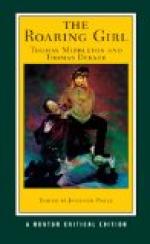|
This section contains 10,055 words (approx. 34 pages at 300 words per page) |

|
SOURCE: “Women in Men's Clothing: Apparel and Social Stability in The Roaring Girl,” in English Literary Renaissance, Vol. 14, No. 3, Autumn 1984, pp. 367-91.
In the essay below, Rose argues that The Roaring Girl, with its depiction of the cross-dressing Moll Frith, presents “an image of Jacobean society as unable to absorb one of its most vital and complex creations into the existing social and sexual hierarchies.”
The central figure in Thomas Middleton and Thomas Dekker's city comedy The Roaring Girl (c. 1608-1611) is a woman named Moll Frith, whose distinguishing feature is that she walks around Jacobean London dressed in male clothing.1 It should be stressed that Moll is not in disguise: she is neither a disguised player, a man pretending to be a woman; nor is she a disguised character, whose role requires a woman pretending to be a man. Unlike the disguised heroines of romantic comedy, Moll...
|
This section contains 10,055 words (approx. 34 pages at 300 words per page) |

|


